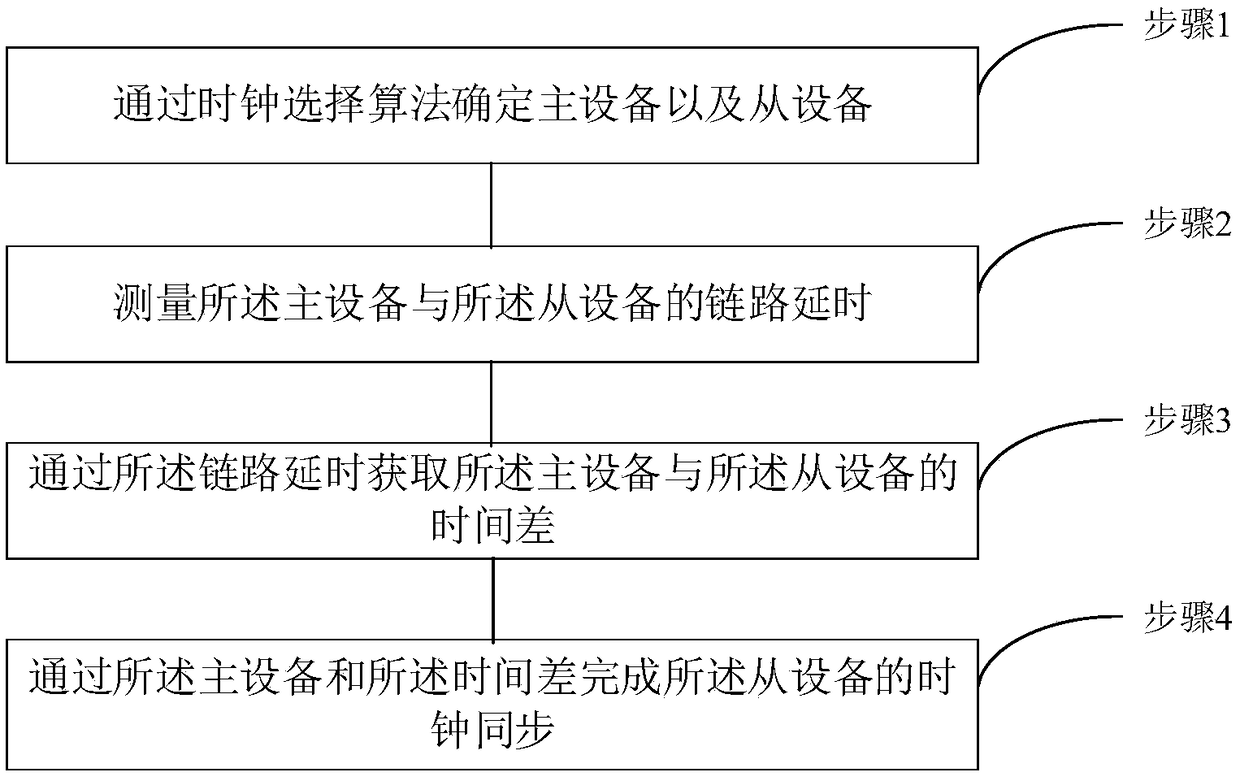Distributed network clock synchronization method
A distributed network and clock synchronization technology, applied in the field of electronics and communication, can solve the problems of different time signal delay, unable to achieve synchronization accuracy, insufficient us-level time accuracy, etc., and achieve strong robustness and reliable time synchronization scheme. Effect
- Summary
- Abstract
- Description
- Claims
- Application Information
AI Technical Summary
Problems solved by technology
Method used
Image
Examples
Embodiment 1
[0051] See figure 1 , figure 1 It is a flowchart of a distributed network clock synchronization method provided by an embodiment of the present invention. The clock synchronization method of the present invention can be used for clock synchronization of a distributed network, and is applied to a distributed network. Specifically, the method includes the following steps:
[0052] Step 1. Determine the master device and the slave device through the clock selection algorithm;
[0053] Step 2, measuring the link delay between the master device and the slave device;
[0054] Step 3, acquiring the time difference between the master device and the slave device through the link delay;
[0055] Step 4. Complete the clock synchronization of the slave device through the master device and the time difference.
[0056] Among them, before step 1, it may also include:
[0057] Step X1, judging whether each device in the distributed network supports the clock synchronization protocol;
...
Embodiment 2
[0090] See figure 2 , figure 2 It is a schematic diagram of the implementation flow of a distributed network clock synchronization method provided by the embodiment of the present invention; image 3 It is a schematic diagram of the principle of measuring link delay of a distributed network clock synchronization method provided by the embodiment of the present invention; Figure 4 It is a schematic diagram of a clock synchronization principle of a distributed network clock synchronization method provided by an embodiment of the present invention. This embodiment further describes the clock synchronization method in detail on the basis of the foregoing embodiments. Specifically, the method includes the following steps:
[0091] Step 1. Send and receive messages
[0092] Each node in the distributed network is a time-aware system, and each time-aware system corresponds to a device, each device. When each node in the distributed network is powered on, that is, after each d...
Embodiment 3
[0116] A distributed network is formed by the interconnection of node machines distributed in different locations and having multiple terminals. Any point in the network is connected to at least two lines. When any line fails, the communication can be completed through other links, which has high reliability. At the same time, the network is easy to expand.
[0117]Preferably, all nodes in the distributed network constitute a clock synchronization system domain, and all nodes in the domain include clock sources, bridges and end stations respectively, wherein the number of clock sources is one, and the number of end stations is at least one, The number of bridges is at least one. Each node in the distributed network is a time-aware system, that is, clock sources, bridges and end stations are all time-aware systems.
[0118] Preferably, the time awareness system includes: a synchronous site synchronous site module (Sitesync), a first port (portsync 1), a second port (portsync 2...
PUM
 Login to View More
Login to View More Abstract
Description
Claims
Application Information
 Login to View More
Login to View More - R&D
- Intellectual Property
- Life Sciences
- Materials
- Tech Scout
- Unparalleled Data Quality
- Higher Quality Content
- 60% Fewer Hallucinations
Browse by: Latest US Patents, China's latest patents, Technical Efficacy Thesaurus, Application Domain, Technology Topic, Popular Technical Reports.
© 2025 PatSnap. All rights reserved.Legal|Privacy policy|Modern Slavery Act Transparency Statement|Sitemap|About US| Contact US: help@patsnap.com



